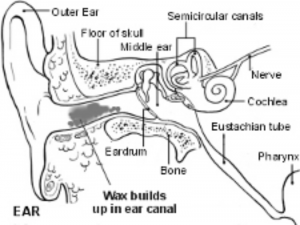If there is a build up of wax in your ear(s) please read the following self-help guide as you may not need an appointment.
What is ear wax?
Ear wax is normal and is produced to form a protective coating over the skin in the ear canal. Ears are normally self-cleaning – the movement of your jaw whilst eating and talking helps to move the wax along the canal where it will usually fall out naturally without you noticing.
Why is my ear blocked with wax?
The amount of ear wax produced varies from person to person. Some people produce excessive amounts which can lead to a blockage in the ear canal.

You are more likely to develop a blockage of wax in the canal if you:
- Use cotton ear buds to clean the ear as this pushes the wax deeper into the canal
- Wear a hearing aid, ear plugs or use in-ear speakers/headphones – as these can all interfere with the natural process of wax expulsion
- Have narrow ear canals
- Have hairy ear canals
- Are elderly – because the ear wax you produce is drier and harder
- Have a dry skin problem such as eczema or psoriasis
Advice to help you manage and prevent ear wax blockage
Ear wax only becomes a problem if it causes deafness, discomfort or if a health professional requires a clear view or your ear drum.
If you experience any of the following, you should seek advice from your GP or Practice Nurse
- Pain
- Discharge or bleeding from the ear
- Sudden deafness or buzzing
- Foreign bodies in the ear
- Dizziness
If you are not experiencing any of the above, we recommend that you manage the blockage as outlined below.
Olive Oil Drops
The following needs to be done 2-3 times daily for 14 days.
- Lie on your side with the affected ear uppermost
- Pull the outer ear gently backwards and upwards which straightens the ear canal
- Put 2-3 drops of olive oil into the affected ear(s) and gently massage just in front of the ear
- Stay lying on your side to allow the wax to soak in for around 10 mins
- Afterwards, wipe away any excess oil but do not plug your ear with cotton wool as this simply absorbs the oil
Your hearing problem may initially worsen after first starting to use the olive oil drops. We therefore advise you to treat one ear at a time if both ears are blocked with wax.
In most cases, after 14 days, the wax will have softened sufficiently to encourage the wax to come out without further intervention. However, if you feel your hearing is still impaired, please move to the next step, which is to try bulb syringing.
Bulb Syringing
There are now available kits over-the-counter from pharmacies and supermarkets. If you have already softened the wax with olive oil for 14 days, you should find that you can use the bulb syringe to successfully remove any wax that has not already come out. If you have attempted this and still have a problem, please contact the practice to discuss ear syringing.
Ear Syringing
This is now only carried out by the surgery if the above recommendations have proved to be unsuccessful. You will need an appointment with a GP to examine your ears to determine why the above measures have not worked. Depending on the outcome of the examination, your GP can arrange an appointment for ear syringing.
Ear wax needs to be softened for a minimum of 7 days before attempting to syringe. Although the risks are low and our nursing staff are specially trained to perform this procedure, there is still a small chance (thought to be around 1 in 1000) of complications occurring – such as a perforated ear drum, middle ear infection, external canal infection or causing ringing in the ear (tinnitus).
If your ears are regularly becoming blocked with wax, after clearing the blockage we will usually suggest you use olive oil drops as above around once per week to keep the wax soft and encourage the natural process of wax expulsion.
Useful Link:
